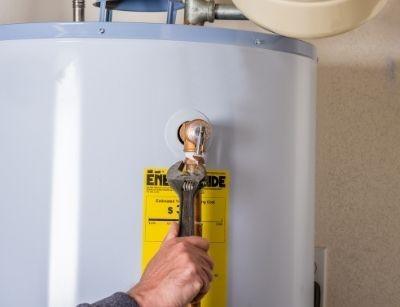
Article Section Link:
- What is a Water Heater Recover Rate?
- Determining Your Water Heater’s Recovery Rate
- Water Heater Flushing as Maintenance for Optimal Recovery Times
- How Long Does It Take to Drain a Water Heater
- Sediment Affects Gas and Electric Water Heaters
- Other Issues That Can Lead to Longer Recovery Times
One issue with traditional water heater tanks is that you can quickly run out of hot water. When you use up all of the hot water in a traditional water heater, you will be left with cold water for 30 minutes to two hours, depending on the size and efficiency of the heating tank. This is why many people opt to switch to tankless water heaters, which provide a limitless hot water supply. However, making this switch isn’t necessary if you know about your hot water tank’s recovery rate and utilize it to your advantage.
What is a Water Heater Recover Rate?
The recovery rate, otherwise referred to as recovery time, is defined as the time it takes for a water heater tank to reach the desired temperature. The length of the recovery time of a water heater depends on several factors, such as the tank’s size, whether it is gas or electric, its maintenance condition, and its efficiency rating. Calculating the recovery rate is important because it will tell you approximately how long you’ll have to wait before you have hot water again. It can also help you identify when your water heater isn’t functioning at an optimal level, suggesting required water heater repairs or a replacement.
Determining Your Water Heater’s Recovery Rate
Recovery times can vary from one water heater to the next. The only real way to determine your unit’s recovery time is use up all the hot water, set a timer and wait for the temperature rise to the appropriate level.
Finding the Recovery Time After the Hot Water Runs Out
- Wait at least 30 minutes before checking the tank temperature.
- Turn the tap on and let it run for about 20 seconds
- Use an instant-read kitchen thermometer to measure the water temperature.
- If the water temperature hasn’t yet reached what your water heater is set to, shut the water back off and then measure the temperature again 15 minutes later.
- Continue checking the temperature every 15 minutes until it is finally at the right temperature.
After following these steps and getting the hot water to reach the desired temperature, you will have figure out the recovery and efficiency rates of the water heater.
If you notice that the recovery time has increased, you may need to ask a local plumber or professional water heater repair tech who can check for the underlying problem.
Water Heater Flushing as Maintenance for Optimal Recovery Times
Water heaters aren’t as efficient as they should be because of sediment buildup on the bottom of the tank. That buildup—minerals that have solidified over time—gets in the way of the heating element. As a result, your hot water recovery rate slows down.
Make sure to have your water heater flushed at least once a year!
How Long Does It Take to Drain a Water Heater
You should aim to have your water heater flushed at least once a year. That maintenance can really pay off in the long run.
Flushing a water heater—especially one of the larger ones—can take anywhere from 15 to 30 minutes for a 40- to 60-gallon tank. Bigger units can take an hour or longer. What determines how long it takes to drain a tank is the size of the tank and how quickly water can exit through the drain valve. Sediment buildup can make that process even harder by clogging the valve.
To speed up the process, you can try opening a hot water faucet to relieve some pressure. A wider hose can also help. But remember, setting up and refilling the tank will add to the overall time needed.
Sediment Affects Gas and Electric Water Heaters
Gas Water Heaters
Sediment build-up can affect both gas and electric water heaters in different ways. In gas water heaters, all of the sediment at the bottom of the tank basically acts like a layer of insulation that blocks much of the heat and can drastically increase the recovery time.
Sediment buildup can also create hot spots that can weaken the tank and increase the chances of it leaking. Any loud banging or knocking noises produced by a hot water heater is also a sign of the sediment being disturbed and colliding with the side of the tank.
Electric Water Heaters
Electric water heaters are different in that they don’t only heat from the bottom. Instead, these units have two electric heating elements—one at the bottom of the tank and one in the upper half. The issue here is that the sediment can damage the lower heating element and cause it to not work as well or fail completely, both of which will lead to longer recovery times.
Other Issues That Can Lead to Longer Recovery Times
It is important that your water heater is using an efficient heating capacity and is providing you with the hot water required for everyday needs. Here are some more reasons why the recovery rate of your tank isn’t the best—
- The hot water tank is older (closer to 10-15 years)
- Malfunctioning or dirty burners inside the tank
- Poor maintenance
- Higher energy bills
Is it Time for a New Water Heater Installation or Repair?
If you’re experiencing long recovery times or any other water heater issues, the experts at Apex Pros can quickly diagnose and determine the problem. We specialize in a full range of water heater services are ready to assist with repairs, maintenance, or water heater replacement needs. Read our 5 Star Reviews!
We work on all brands and models of both tank-style and tankless water heaters and can also help with any of your other plumbing, sewer or HVAC needs. Give us a call today if you need to schedule a water heater inspection or any other service in the Central Ohio and Dayton Metro areas.






